Language Proficiency of Teachers
As of December 2000 |
|---|
NATIONAL (n=248)
134 (55%) programs report 100% of teachers are proficient in both languages
34 (14%) programs report 79-99% of teachers are proficient in both languages
21 (8%) programs report 51-75% of teachers are proficient in both languages
26 (10%) programs report 50% of teachers are proficient in both languages
11 (4%) programs report 0-49% of teachers are proficient in both languages
22 (9%) unreported
|
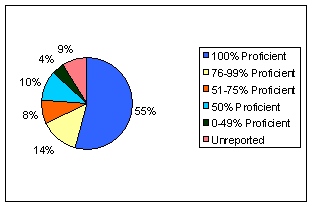 |
CALIFORNIA (n=86)
60 (70%) programs report 100% of teachers are proficient in both languages
10 (12%) programs report 79-99% of teachers are proficient in both languages
4 (5%) programs report 51-75% of teachers are proficient in both languages
2 (2%) programs report 50% of teachers are proficient in both languages
1 (1%) programs report 0-49% of teachers are proficient in both languages
9 (10%) unreported
|
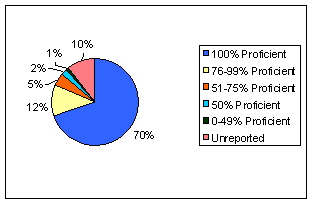 |
TEXAS (n=34)
14 (40%) programs report 100% of teachers are proficient in both languages
7 (21%) programs report 79-99% of teachers are proficient in both languages
2 (6%) programs report 51-75% of teachers are proficient in both languages
5 (15%) programs report 50% of teachers are proficient in both languages
3 (9%) programs report 0-49% of teachers are proficient in both languages
3 (9%) unreported
|
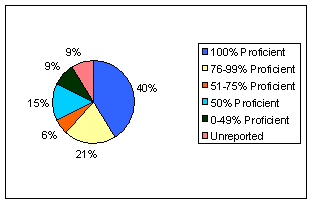 |
NEW YORK (n=20)
9 (45%) programs report 100% of teachers are proficient in both languages
2 (10%) programs report 79-99% of teachers are proficient in both languages
2 (10%) programs report 51-75% of teachers are proficient in both languages
5 (25%) programs report 50% of teachers are proficient in both languages
0 programs report 0-49% of teachers are proficient in both languages
2 (10%) unreported
|
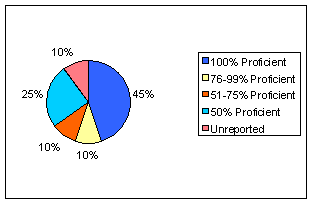 |
Language Proficiency of Support Staff
As of December 2000 |
|---|
NATIONAL (n=248)
72 (28%) programs report 100% of staff are proficient in both languages
19 (8%) programs report 79-99% of staff are proficient in both languages
19 (8%) programs report 51-75% of staff are proficient in both languages
19 (8%) programs report 50% of staff are proficient in both languages
14 (6%) programs report 0-49% of staff are proficient in both languages
59 (23%) unreported
46 (19%) have no support staff
|
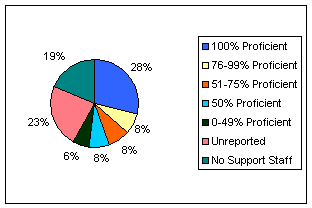 |
CALIFORNIA (n=86)
28 (33%) programs report 100% of staff are proficient in both languages
5 (6%) programs report 79-99% of staff are proficient in both languages
3 (3%) programs report 51-75% of staff are proficient in both languages
2 (2%) programs report 50% of staff are proficient in both languages
7 (8%) programs report 0-49% of staff are proficient in both languages
37 (43%) unreported
4 (5%) have no support staff
|
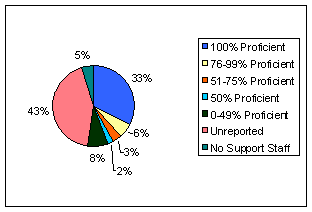 |
TEXAS (n=34)
15 (43%) programs report 100% of staff are proficient in both languages
3 (9%) programs report 79-99% of staff are proficient in both languages
2 (6%) programs report 51-75% of staff are proficient in both languages
2 (6%) programs report 50% of staff are proficient in both languages
2 (6%) programs report 0-49% of staff are proficient in both languages
6 (18%) unreported
4 (12%) have no support staff
|
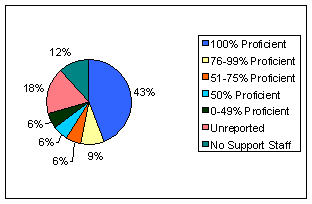 |
NEW YORK (n=20)
4 (20%) programs report 100% of staff are proficient in both languages
3 (15%) programs report 79-99% of staff are proficient in both languages
1 (5%) program reports 51-75% of staff are proficient in both languages
3 (15%) programs report 50% of staff are proficient in both languages
0 programs report 0-49% of staff are proficient in both languages
7 (35%) unreported
2 (10%) have no support staff
|
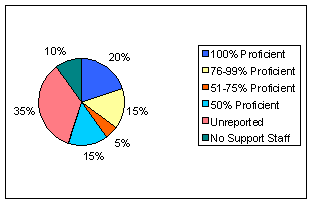 |







